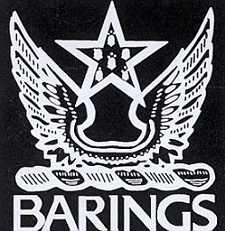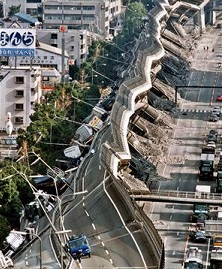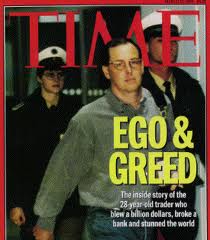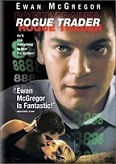By Jesse Colombo (This article was written on March 15th, 2005)
 In February of 1995, one man single-handedly bankrupted the bank that financed the Napoleonic Wars, Louisiana Purchase and the Erie Canal. Founded in 1762, Barings Bank was Britain’s oldest merchant bank and Queen Elizabeth’s personal bank. Once a behemoth in the banking industry, Barings was brought to its knees by a rogue trader in a Singapore office. The trader, Nick Leeson, was employed by Barings to profit from low risk arbitrage opportunities between derivatives contracts on the Singapore Mercantile Exchange and Japan’s Osaka Exchange. A scandal ensued when Leeson left a $1.4 billion hole in Barings’ balance sheet due to his unauthorized derivatives speculation, causing the 233-year-old bank’s demise.
In February of 1995, one man single-handedly bankrupted the bank that financed the Napoleonic Wars, Louisiana Purchase and the Erie Canal. Founded in 1762, Barings Bank was Britain’s oldest merchant bank and Queen Elizabeth’s personal bank. Once a behemoth in the banking industry, Barings was brought to its knees by a rogue trader in a Singapore office. The trader, Nick Leeson, was employed by Barings to profit from low risk arbitrage opportunities between derivatives contracts on the Singapore Mercantile Exchange and Japan’s Osaka Exchange. A scandal ensued when Leeson left a $1.4 billion hole in Barings’ balance sheet due to his unauthorized derivatives speculation, causing the 233-year-old bank’s demise.
Nick Leeson grew up in London’s Watford suburb and worked for Morgan Stanley after graduating from university. Shortly after, Leeson joined Barings and was transferred to Jakarta, Indonesia to sort through a back-office mess involving £100 million of share certificates. Nick Leeson enhanced his reputation within Barings when he successfully rectified the situation in 10 months (Risk Glossary).
In 1992, after his initial success, Nick Leeson was transferred to Barings Securities in Singapore and was promoted to general manager, with the authority to hire traders and back office staff. Leeson’s experience with trading was limited, but he took an exam that qualified him to trade on the Singapore Mercantile Exchange (SIMEX) alongside his traders. According to Risk Glossary:
“Leeson and his traders had authority to perform two types of trading:
1. Transacting futures and options orders for clients or for other firms within the Barings organization, and
2. Arbitraging price differences between Nikkei futures traded on the SIMEX and Japan’s Osaka exchange.
Arbitrage is an inherently low risk strategy and was intended for Leeson and his team to garner a series of small profits, rather than spectacular gains.”
As a general manager, Nick Leeson oversaw both trading and back office functions, eliminating the necessary checks and balances usually found within trading organizations. In addition, Barings’ senior management came from a merchant banking background, causing them to underestimate the risks involved with trading, while not providing any individual who was directly responsible for monitoring Leeson’s trading activities (eRisk). Aided by his lack of supervision, the 28-year-old Nick Leeson promptly started unauthorized speculation in Nikkei 225 stock index futures and Japanese government bonds (Risk Glossary). These trades were outright trades or directional bets on the market. This highly leveraged strategy can provide fantastic gains or utterly devastating losses – a stark contrast to the relatively conservative arbitrage trading that Barings had intended for Leeson to pursue.
monitoring Leeson’s trading activities (eRisk). Aided by his lack of supervision, the 28-year-old Nick Leeson promptly started unauthorized speculation in Nikkei 225 stock index futures and Japanese government bonds (Risk Glossary). These trades were outright trades or directional bets on the market. This highly leveraged strategy can provide fantastic gains or utterly devastating losses – a stark contrast to the relatively conservative arbitrage trading that Barings had intended for Leeson to pursue.
Nick Leeson opened a secret trading account that was numbered “88888” to facilitate his surreptitious trading. Risk Glossary says of Leeson:
He lost money from the beginning. Increasing his bets only made him lose more money. By the end of 1992, the 88888 account was under water by about GBP 2MM. A year later, this had mushroomed to GBP 23MM. By the end of 1994, Leeson’s 88888 account had lost a total of GBP 208MM. Barings management remained blithely unaware.
As a trader, Leeson had extremely bad luck. By mid February 1995, he had accumulated an enormous position—half the open interest in the Nikkei future and 85% of the open interest in the JGB [Japanese Government Bond] future. The market was aware of this and probably traded against him. Prior to 1995, however, he just made consistently bad bets. The fact that he was so unlucky shouldn’t be too much of a surprise. If he hadn’t been so misfortunate, we probably wouldn’t have ever heard of him.
 Betting on the recovery of the Japanese stock market, Nick Leeson suffered monumental losses as the market continued its descent. In January 1995, a powerful earthquake shook Japan, dropping the Nikkei 1000 points while pulling Barings even further into the red. As an inexperienced trader, Leeson frantically purchased even more Nikkei futures contracts in hopes of winning back the money that he had already lost. Most successful traders, however, are quick to admit their mistakes and cut their losing trades.
Betting on the recovery of the Japanese stock market, Nick Leeson suffered monumental losses as the market continued its descent. In January 1995, a powerful earthquake shook Japan, dropping the Nikkei 1000 points while pulling Barings even further into the red. As an inexperienced trader, Leeson frantically purchased even more Nikkei futures contracts in hopes of winning back the money that he had already lost. Most successful traders, however, are quick to admit their mistakes and cut their losing trades.
Surprisingly, Nick Leeson effectively managed to avert suspicion from senior management through his sly use of account number 88888 for hiding losses, while he posted profits in other trading accounts. In 1994, Leeson fabricated £28.55 million in false profits, securing his reputation as a star trader and gaining bonuses for Barings’ employees (Risk Glossary). Despite the staggering secret losses, Leeson lived the life of a high roller, complete with a $9,000 per month apartment and earning a bonus of £130,000 on his salary of £50,000, according to “How Leeson Broke the Bank.”
The horrific losses accrued by Nick Leeson were due to his financial gambling as he placed his trades based upon his emotions rather than through taking calculated risks. After the collapse of Barings, a worldwide outrage ensued, decrying the use of derivatives. The truth, however, is that derivatives are only as dangerous as the
 Nick Leeson was placed on trial in Singapore and was convicted of fraud. He was sentenced to six and a half years in a Singaporean prison, where he contracted cancer (Risk Glossary). He survived his cancer, and, while imprisoned, wrote an autobiography called “Rogue Trader,” detailing his role in the Barings scandal. “Rogue Trader” was eventually made into a movie of the same name. Nick Leeson was released from prison in July 1999 for good behavior.
Nick Leeson was placed on trial in Singapore and was convicted of fraud. He was sentenced to six and a half years in a Singaporean prison, where he contracted cancer (Risk Glossary). He survived his cancer, and, while imprisoned, wrote an autobiography called “Rogue Trader,” detailing his role in the Barings scandal. “Rogue Trader” was eventually made into a movie of the same name. Nick Leeson was released from prison in July 1999 for good behavior.
Other Barings Bank Collapse & Nick Leeson Resources:
Nick Leeson and the Failure of Barings Bank
Nick Leeson’s Official Website
References:
“Barings Case Study.” eRisk.com. February 2004. eRisk. 12 March 2005. <http://www.erisk.com/Learning/CaseStudies/ref_case_barings.asp>
“How Leeson Broke the Bank.” BBC Online. June 22, 1999. British Broadcasting Company. 12 March 2005. <http://news.bbc.co.uk/2/hi/business/375259.stm>
“Nick Leeson and Barings Bank.” RiskGlossary.com. January 1996. Contingency Analysis. 12 March 2005. <http://www.riskglossary.com/articles/barings_debacle.htm>

